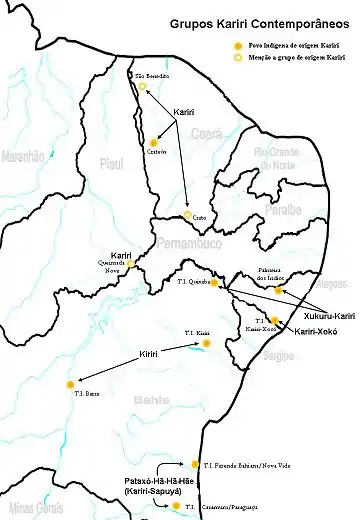Kiriri people
Kiriri people are indigenous people of Eastern Brazil. Their name is also spelled Cariri or Kariri and is a Tupi word meaning "silent" or "tactiturn."[1]
 Map of traditional Kiriri territory | |
| Total population | |
|---|---|
| 1,612 (2006)[1] | |
| Regions with significant populations | |
| Languages | |
| Portuguese, formerly Kariri | |
| Religion | |
| Toré religion |
History
The French Capuchin missionary Martin of Nantes (1638–1714) was the apostle of the Kariri people on the São Francisco River between 1672 and 1683.
The various Kariri peoples were settled in different towns (aldeia) and villages (vila), listed as follows.[2]
| Captaincy | Town or municipality | Village or location | Patron saint | Missionary order | Group |
|---|---|---|---|---|---|
| Bahia | Jaguaripe do Rio da Aldeia | Jaguaripe | Sto. Antônio | Clerics Brotherhood | Kariri |
| Bahia | Conquista da Pedra Branca | Cachoeira | Kariri | ||
| Bahia | Caranguejo | Cachoeira | Sapuyá | ||
| Bahia | Rio Real | Vila da Abadia | Jesus, Maria, José | Carmelite | Kiriri |
| Bahia | Aramaris | São João da Água Fria | Clerics Brotherhood | Kiriri | |
| Bahia | Natuba | Itapicuru | N. Sra. da Conceição | Jesuit | Kiriri |
| Bahia | Canabrava | Itapicuru | Sta. Teresa | Jesuit | Kiriri |
| Bahia | Saco dos Morcegos | Itapicuru | Ascensão de Cristo | Jesuit | Kiriri |
| Bahia | Massacará | Itapicuru | Sma. Trindade | Franciscan | Kiriri, Kaimbé |
| Sergipe | Juru | Lagarto | N. Sra. do Socorro | Jesuit | Kiriri |
| Pernambuco | Gameleira | Alagoas | N. Sra. das Brotas | Clerics Brotherhood | Kariri, Língua Geral and Uruá |
| Pernambuco | São Brás | Penedo | N. Sra. do Ó | Jesuit | Kariri and Progéz |
| Pernambuco | Ilha do Pambu | Rio São Francisco | N. Sra. da Conceição | Capuchin | Kariri |
| Pernambuco | Ilha de Aracapá | Rio São Francisco | S. Francisco | Capuchin | Kariri |
| Pernambuco | Ilha do Cavalo | Rio São Francisco | S. Félix | Capuchin | Kariri |
| Pernambuco | Ilha do Irapuá | Rio São Francisco | Sto. Antônio | Capuchin | Kariri |
| Pernambuco | Ilha de Inhanhuns | Rio São Francisco | N. Sra. da Piedade | Franciscan | Kariri |
| Paraíba | Cariris | Taypu | N. Sra. do Pillar | Capuchin | Kariri |
| Ceará | Miranda | Icó | N. Sra. da Penha de França | Capuchin | Kariri, Quixeréu, Cariú, Cariuané, Calabaça, and Icozinho |
Territory
Today a large portion of their traditional homelands is still called the Cariris region. Within this region are two cities, Crato and Juazeiro do Norte.
The Chapada Diamantina has a dramatic landscape with high plains, table-top mesas, and steep cliffs or towers known as 'tepuy.' Before the arrival of the Portuguese in the 19th century, the only local inhabitants of the region were indigenous Indians from the Maracas and Cariris tribes. In 1985, the Chapada Diamantina National Park was created with its headquarters in Palmeiras.
Kiriri people live in the Kiriri Indigenous Territory, an indigenous territory. Through their successful political organization, they were able to expel 1,200 non-native squatters from their lands since 1990.[1]
Notes
- "Kiriri: Introduction." Povos Indígenas no Brasil. (retrieved 13 Aug 2011)
- DANTAS, Beatriz G., SAMPAIO, José Augusto L. and CARVALHO, Maria do Rosário G. "Os Povos Indígenas no Nordeste Brasileiro: Um Esboço Histórico". In: M. Carneiro da Cunha (org.), História dos Índios no Brasil. São Paulo: FAPESP/SMC/ Companhia das Letras. pp. 431-456. 1992.
